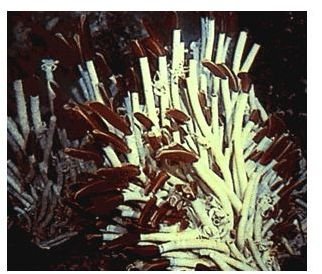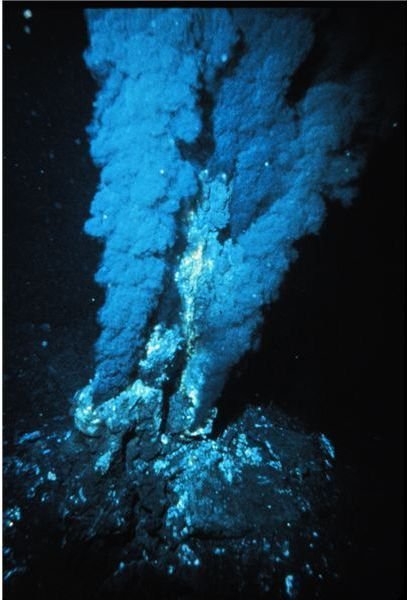Learning About Hydrothermal Vents and Their Creation and Role in Supporting Ocean Life
Beyond the Deep
At 7,000 feet below the surface of the water no light is visible, except for the occasional bio-luminescence or the search lights of a research submersible, and, based on the general workings of organisms, it would be hard to imagine an ecosystem existing in a location devoid of sunlight. Yet, at pressures that would crush your bones, in temperatures close to freezing, there is an oasis for the extreme.
Hydrothermal vents are a fairly recent oceanographic discovery, having only been heavily studied in the past few decades, which present a striking look at the advancing evolution of the Earth’s outer crust and deep sea oceanographic features. With each new research dive, new and profound hydrothermal vents are found throughout the Earth’s oceans, presenting scientists with details on such geological and biological topics as undersea volcanic activity, thermophile behavior and adaptation, and even further evidence towards the concepts of evolution itself.
Some Like it Hot
The accepted origin of hydrothermal vents is from sub-surface water being super heated, coinciding with their predominance around volcanically active regions, by magma causing fissures in the ocean floor. Expelled from these fissures is a collection of various minerals, with the most prominant being sulfide. Because of their location at incredibly deep depths, with the average depth of hydrothermal vents existing at 7,000 feet, the surrounding water is incredibly cold while the expelled solution from the vent is absurdly hot, reaching temperatures close to 850 degrees Fahrenheit. This results in a precipation effect that allows the vents to slowly build into massive columns.
Additionally, some vents can be prematurely born in the form of tectonic plate movement and earthquakes, creating long ridges of hydrothermal vents spanning across the ocean floor.
While there are a number of regions packed with these vents, they are also very scattered across the floor, a fact which will soon to be revealed as a key element of their importance to biological studies.
The Extreme
With temperatures close to the melting point of aluminum and depths reaching as far down as 16,000 feet, you wouldn’t believe that these vents are actually a beacon for life on the ocean floor. However, you’d be surprised to learn that the exact opposite is true. Surveys of biological life on the ocean floor put the density of organisms found near hydrothermal vents as high as 100,000 times greater than that of the surrounding regions. This is strange because such harsh conditions would normally prove difficult for most marine organisms to survive in, much less thrive, but the life around hydrothermal vents is by no means normal.
The majority of life at these depths rely upon “marine snow”, or sinking organic matter, to survive, but the organisms that call hydrothermal vents home are not like the majority of life on the ocean floor. It all starts in the same place as most food chains, very small, in the form of bacteria that feed off of sulfur compounds, which, as was mentioned before, is the primary constituent of the product of hydrothermal vents. These bacteria in turn attract other small organisms like copepods which themselves bring in various types of predators ranging from crustaceans to fish and octopuses.

The most important role in the vent ecosystem is played by the tube worms which, because of their nature of directly absorbing the surrounding nutrients into their tissues, provide bacteria with a rich environment to coexist with the tube worms. This symbiotic relationship helps to maintain a stable ecosystem which has gone on to foster a number of profound developments.
A particular organism which has cemented the importance of studying hydrothermal vents is a species of bacteria which photosynthesizes not from the light of the Sun, but from that of these hydrothermal vents. This is the first organism to ever be seen to exhibit this trait.
Darwin’s Sea Snails
A bacteria which can photosynthesize without the Sun is certainly a marvelous discovery, but a more significant contribution to science is the existence of hundreds of distinct species of gastropods surrounding these hydrothermal vents. Because of their close evolutionary lines, but distinguishable differences, these snails provide further evidence for Darwin’s theory of evolution and natural selection and in a manner befitting that of his original study of the finches found throughout the Galapagos islands.
Controversially, these discoveries have come from thorough scientific studies which themselves are causing a significant level of harm to the environments being studied. This problem has elevated to the point of the conservation status of hydrothermal vents becoming a serious topic of discussion in the oceanography world.
A Landscape Befitting an Astronaut
An interesting note to consider is that we currently have a greater understanding of the surface of the Moon than we do of the floor of our own ocean. While there is no doubt there are a number of hurdles to get over before further studies can take place to change this problem, there should really be no doubt about the consideration behind why such studies should occur.
The ocean floor is riddled with countless discoveries, many of which are being made every time a study is carried out, but many more wait to be made. Hydrothermal vents are no exception to this and while we may have a good idea of their history and effect, we cannot allow that to suspend what new and potentially groundbreaking discoveries that may be found around that undersea oasis.
References
- Hydrothermal Vent Communities - botos.com
- Hydrothermal Vent - NOAA Public Photo Library
- Deep Sea Hydrothermal Vents - Extreme Science
- Tube Worm Community - USGS Public Domain
- Hydrothermal Vents - University of Delaware
